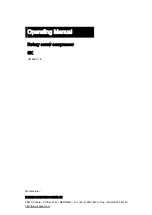
Application Engineering
B U L L E T I N
AE4-1374 R1
since the overload protector setting could be affected.
R-407C may only be used with compressors tested and
approved for use with R-407C and that contain polyol
ester (POE) oil. Compressors containing POE oil have
an
“E” in the seventh place of the model number, e.g.
ZR28K5E-PFV.
Power Supply
All motors for the Copeland Scroll compressors covered
in this bulletin, whether single or three phase, with the
exception of the
“PFV” 208-230, 1Ø, 60 Hz motor, are
designed to operate within a voltage range of +/-10% of
the voltages shown on the nameplate. For example, a
compressor with a nameplate voltage of 200-230 volts
can start and operate within a range of 180-253 volts.
Compressors with a
“PFV” designated motor such as
ZR54K5-PFV, may only be operated in a range of 197-
253 volts under maximum load conditions.
Accumulators
The use of accumulators is very dependent on the
application. The Copeland Scroll compressor
’s inherent
ability to handle liquid refrigerant during occasional
operating flood back situations make the use of an
accumulator unnecessary in standard designs such as
condensing units. Applications such as heat pumps with
orifice refrigerant control that allow large volumes of
liquid refrigerant to flood back to the compressor during
normal steady operation can dilute the oil to such an
extent that bearings are inadequately lubricated, and
wear will occur. In such a case an accumulator must
be used to reduce flood back to a safe level that the
compressor can handle. Heat pumps designed with
a TXV to control refrigerant during heating may not
require an accumulator if testing assures the system
designer that there will be no flood back throughout the
operating range.The accumulator oil return orifice should
be from 0.040 to 0.055 inches (1 - 1.4mm) in diameter
depending on compressor size and compressor flood
back results. A large-area protective screen no finer than
30x30 mesh (0.6mm openings) is required to protect
this small orifice from plugging. Tests have shown that a
small screen with a fine mesh can easily become plugged
causing oil starvation to the compressor bearings. The
size of the accumulator depends upon the operating
range of the system and the amount of subcooling and
subsequent head pressure allowed by the refrigerant
control. System modeling indicates that heat pumps
that operate down to and below 0°F (-18°C) will require
an accumulator that can hold around 70% to 75% of
the system charge. Behavior of the accumulator and
its ability to prevent liquid slugging and subsequent oil
pump-out at the beginning and end of the defrost cycle
should be assessed during system development. This
will require special accumulators and compressors with
© 2013 Emerson Climate Technologies, Inc.
Printed in the U.S.A.
sight tubes and/or sight glasses for monitoring refrigerant
and oil levels.
Charge Compensators
Charge compensators are devices that store excess
refrigerant during the heating operation of a heat pump
with a TXV refrigerant control. Unlike an orifice, a TXV
will not allow excessive refrigerant to flood back to
the compressor. This means that the excess system
refrigerant will either have to back up in the indoor
coil during heating, causing high head pressure, or
be stored in a charge compensator until needed. A
charge compensator is normally a hollow vessel with
only one opening that is attached to the vapor line.
The shell is usually attached to the outdoor coil or has
a line from the outdoor coil running through it for extra
cooling during heating and to drive the refrigerant out
during the cooling cycle. The size is dependent on how
much refrigerant has to be removed from the system
throughout the system operating map.
Screens
Screens finer than 30x30 mesh (0.6 mm openings)
should not be used anywhere in the system with these
compressors. Field experience has shown that finer
mesh screens used to protect thermal expansion
valves, capillary tubes, or accumulators can become
temporarily or permanently plugged with normal system
debris and block the flow of either oil or refrigerant to the
compressor. Such blockage can result in compressor
failure.
Crankcase Heat - Single Phase
A crankcase heater is recommended on single phase
compressors when the system charge is over the
charge limit shown in Table 4. A crankcase heater is
required for systems containing more than 120% of the
compressor refrigerant charge limit listed in Table 4.
This includes long line length systems where the extra
charge will increase the standard factory charge above
the 120% limit.
Experience has shown that compressors may fill with
liquid refrigerant under certain circumstances and
system configurations, notably after long off cycles when
the compressor has cooled. This may cause excessive
start-up clearing noise; or the compressor may start and
trip the internal overload protector several times before
running. The addition of a crankcase heater will reduce
customer noise and dimming light complaints since
the compressor will no longer have to clear out liquid
during starting. Table 5 lists the crankcase heaters
recommended for the various models and voltages.
WARNING! Crankcase heaters must be properly
grounded. To properly install the crankcase heater, the
6







































